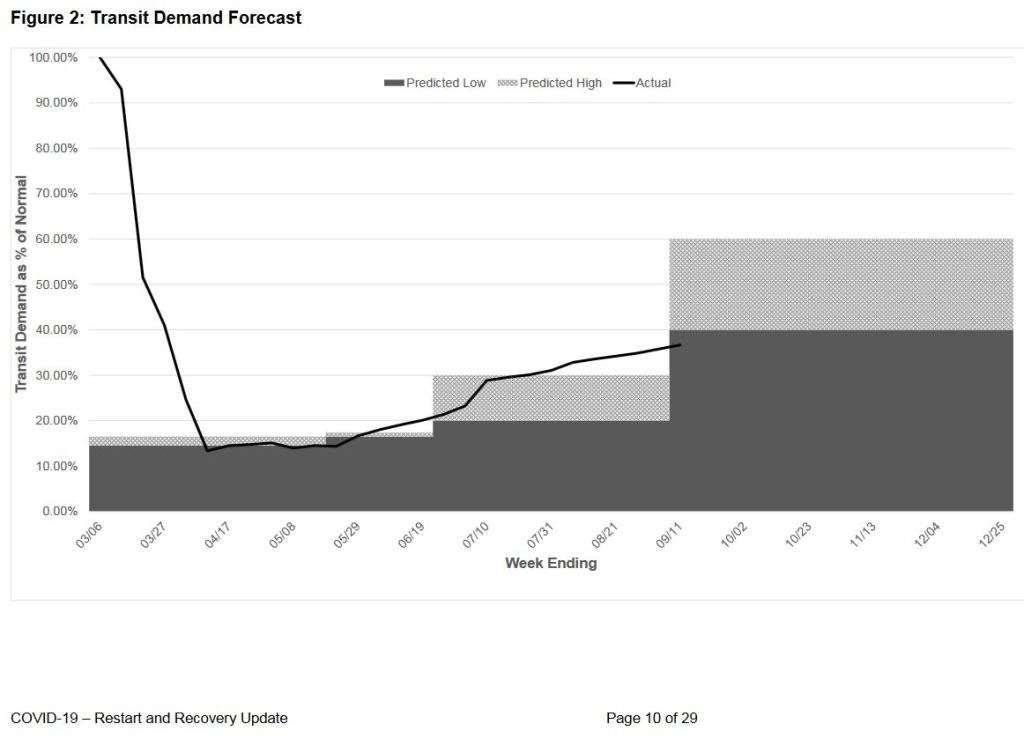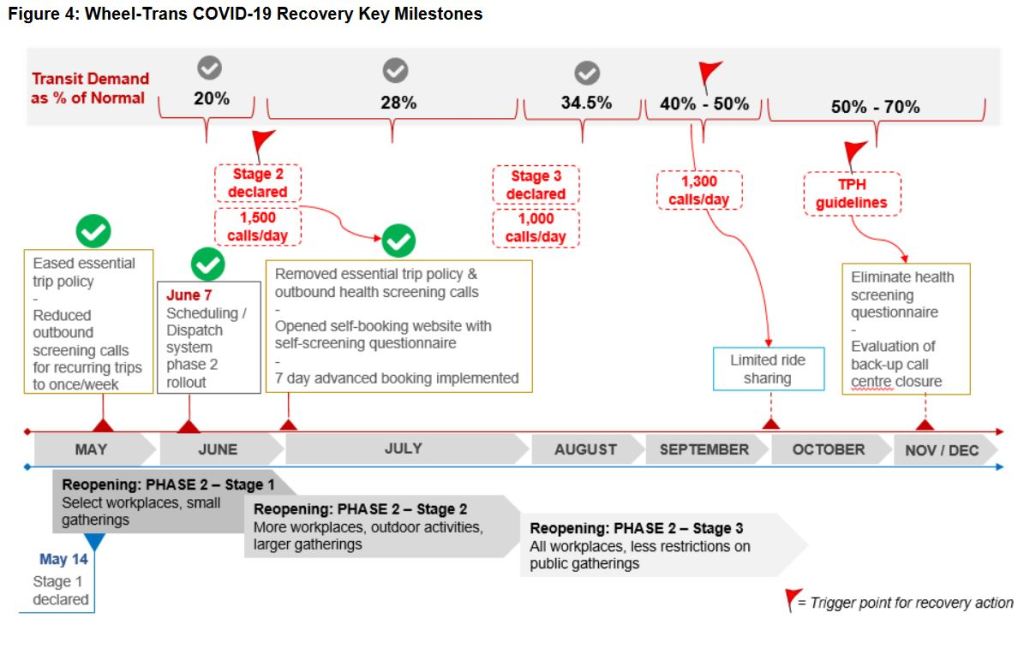At its September 24, 2020 meeting, the TTC Board will consider a report from management on the current status of the “Restart and Recovery” program.
This report contains a variety of information including:
- A review of the physical changes the TTC has been implementing and investigating to improve health and safety on its system.
- Demand and service plans for the coming months.
- Financial projections
- A current survey of rider attitudes to travel on the TTC
This article deals only with the service plans. I will turn to the other components after the TTC meeting.
Conventional System Service
Ridership on the main part of the transit system (excluding Wheel-Trans which I will discuss later) has been growing slowly from the low point in April 2020.

The return of demand varies by mode and this is strongly influenced by the higher proportion of trips to downtown jobs and academic institutions that have been replaced by work-from-home arrangements.

The bus system is back at about half of its normal demand although the subway is at only about a third. The TTC does not plan to restore full service until the system as a whole reaches 50%, but is running extra unscheduled buses on routes where crowding is a problem. As I have previously reported, the TTC does not list where and when these extras are used, nor does it routinely publish crowding statistics.
A big problem with the 49% level for bus boardings compared to pre-covid conditions is that this is an average. It blends data from all routes, all times of day, and all parts of the city. There will be places and times of lower demand and places where routes are as crowded as pre-covid. This is borne out by photos posted on social media by riders.
Certain types of trips, indeed even the potential for some trips, will not return to the system until “normal” times especially for special events and entertainment. School travel at all levels will run below “normal” while classes are provided via distance learning for the safety of students.
This will dilute the returning numbers of workers who continue to use the TTC and bring down the overall percentages even though some routes will see demand well over the 50% level, but with less than 100% of the pre-covid service.
Overall crowding levels are shown in the chart below which is driven by Automatic Passenger Counter (APC) data. As ridership grows, the proportion of trips running above 30% or 50% of capacity (reference points for acceptable crowding in stages of the recovery plan) have also grown. Note that this includes the benefits of whatever unscheduled extra service the TTC has operated.

What is badly needed is a better public understanding of where crowding is a problem at the route and time of day level, not simply on an average basis across the system. Only in this context can the addition or redeployment of resources — drivers and buses, not to mention funding — make sense.
The TTC plans some service improvements in coming months:
- Starting in September, the TTC is dispatching extra buses to deal with the rise in school trips as elementary and secondary schools re-open and some of their population returns as TTC riders.
- In October, the TTC will make improvements on Eglinton East to take advantage of the recently installed bus lanes. This will include restoration of 905 Eglinton East and 986 Scarborough express services.
- In November, more express services will return and local services will be improved by using some of the buses and drivers now operating on demand-based standby service.
The October changes will be accomplished by reallocating service from poor-performing routes, and it will be interesting to see which routes are on the chopping block. Indeed, it would be useful to see a full list of routes and service periods that are under threat of service cuts considering that full funding for 2021 is far from certain. For 2021, any new services will have to compete with existing routes for resources.
An important distinction in service design that will be with us for some time will be the spreading of the “peak” period, or more accurately a lower demand at the height of the peaks resulting in more uniform demand and service levels. This has been part of the schedule design for recent months when “trippers” that ordinarily would be in service for only a few hours in each peak operated for 6-7 hours/day with only a brief mid-day window between the “AM” and “PM” peak service levels.
Another issue related to core area demand will be the degree to which non-core oriented trips take a proportionately larger role on the TTC and how network and service designs react to this.
Travel between suburbs has always been more difficult than travel to and from downtown because so much service is oriented to feeding the subway network. Coming months provide a chance to address this problem with a stronger focus on the surface network and the areas it serves.
For 2021, various options are part of TTC planning:
- Continuation of some demand-responsive service to allow quick adjustments as travel patterns evolve.
- The potential effect of a “second wave” that could affect both ridership and the level of distancing required on transit vehicles.
- Adjusting service patterns and network structure, as discussed above, to react to and support new patterns of demand.
- Improve service reliability (a subject of several recent articles on this site).
- Continue the RapidTO plan of creating more exclusive bus lanes.
- Cross-border service and fare integration with systems in the 905.
- Micro-transit and automated shuttle services (*).
(*) The last bullet is quite clearly a sop to the political forces at Queen’s Park where there are assumptions that large savings can be had by using self-driving mini-buses and/or some form of alternate transit to replace lightly used routes. The big problems on the TTC are on routes where these options are hopelessly inadequate, and yet there will be pressure to focus on them as some sort of magic bullet for transit budget problems.
Public consultation regarding the 2021 Service Plan is now in progress with the intent of reporting to the Board late in 2020. The big unknown for next year is the state of the TTC Budget and the possibility that the system will face arbitrary cutbacks to fit within a City and Provincial budget envelope.
Wheel-Trans
Although Wheel-Trans is a much smaller operation than the “conventional” system, ridership has been returning to it roughly in line with the rest of the surface system. Demand is expected to be close to 50% of pre-covid levels by the end of 2020.

As demand rises, the ability to distance on WT services will begin to be difficult and some ride-sharing will have to occur starting in late September.
WT ridership is a particular challenge for the TTC on three counts:
- The ratio of a fully-loaded vehicle to one operating at covid-based distancing and capacity is much higher for WT than for regular TTC vehicles. This means that distancing problems kick in much sooner as demand grows on the WT network compared with the “conventional” one.
- The TTC has attempted to shift WT riders to its “family of services” model where trips are taken part by a WT ride and partly on the conventional system. However, crowding issues, already challenging for some WT users under “normal” circumstances, are more of a problem with limited capacity on buses.
- The WT user community has a higher proportion of riders with risk factors for covid exposure and their concerns about behaviour by other riders are heightened.
Coming Soon …
I will update this article with additional information, if any, from the TTC Board meeting.



